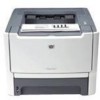HP P2015 Service Manual - Page 83
Timing, Table, Sequence, operation - formatter
 |
UPC - 882780491984
View all HP P2015 manuals
Add to My Manuals
Save this manual to your list of manuals |
Page 83 highlights
Timing Sequence of operation Operation sequences are controlled by the microprocessor on the DC controller. Table 5-1 Sequence of operation on page 73 describes engine operations for each period of a print operation. Table 5-1 Sequence of operation Name Timing Purpose WAIT From power-on until the end of the main motor initial drive Detects presence of a print cartridge. Clears potential from the drum surface and cleans the transfer roller. STBY (standby) From the end of the WAIT or LSTR period until either a print command is sent from the formatter or the power is turned off. Prepares the printer to receive print commands INTR (initial rotation) From the time of the print command until the pickup Prepares the photosensitive drum for printing. solenoid is turned on. PRINT LSTR (last rotation) From the end of the INTR period until the primary high-voltage is turned off. From the end of the PRINT period (when highvoltage is turned off) until the main motor stops rotating. Forms the image on the photosensitive drum and transfers the toner image to the media. Delivers the last page of a print job. After LSTR, the printer either returns to STBY or, if another print command was sent from the formatter, enters INTR. Power-on sequence Table 5-2 Power-on sequence Step 1 2 3 4 5 6 7 8 9 10 Action Power-on CPU initialization Video interface communication start Check sensors for residual media Main motor initial drive Fuser heater initial drive. The fuser heater reaches a surface temperature of 100°C. Laser/scanner motor initial drive High-voltage control Detect presence of a print cartridge Clean the transfer roller after the primary charging ac bias is turned on Failure/abnormality check: detect laser/scanner failure, fuser failure, and open covers Communication with the memory tag ENWW Timing 73















